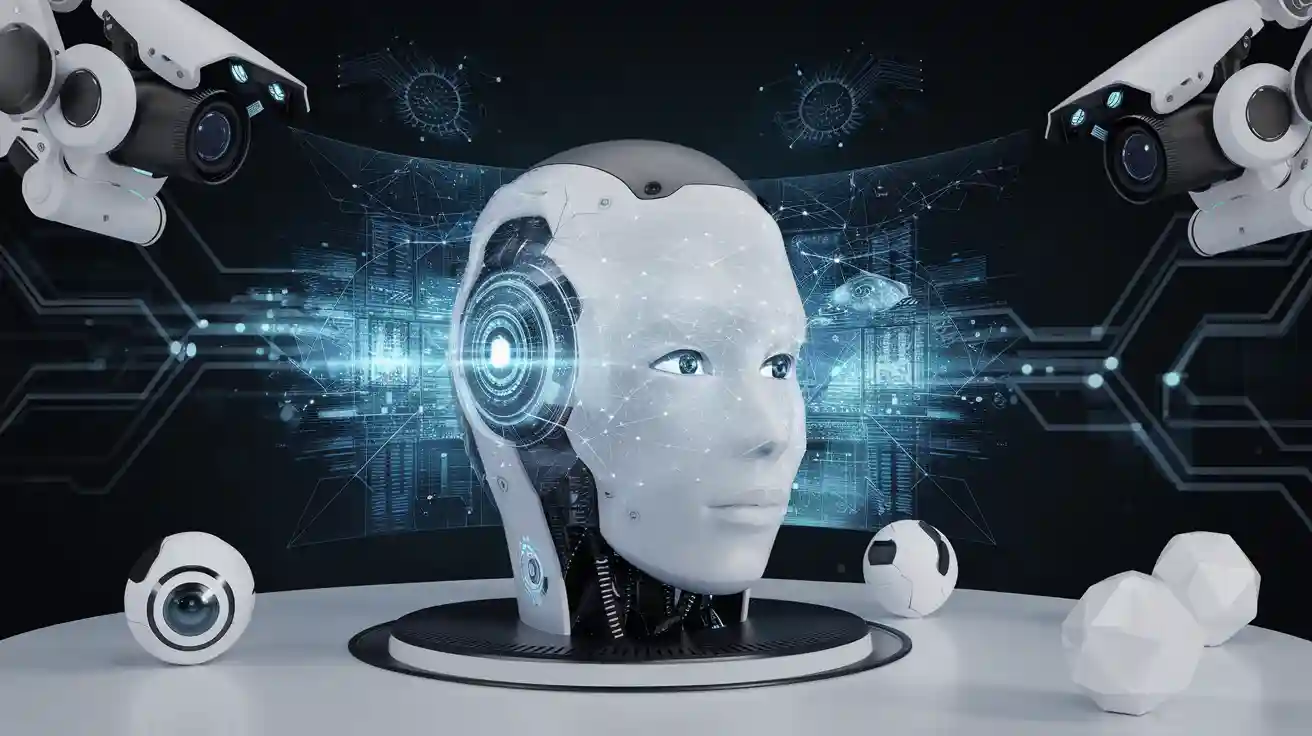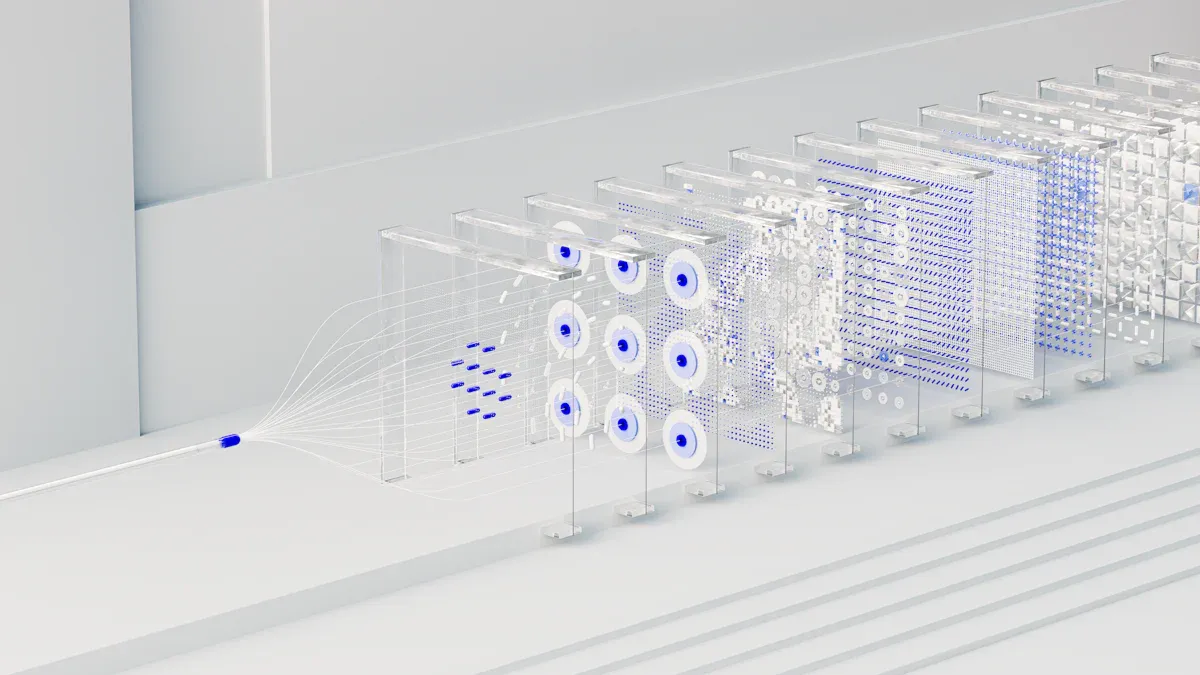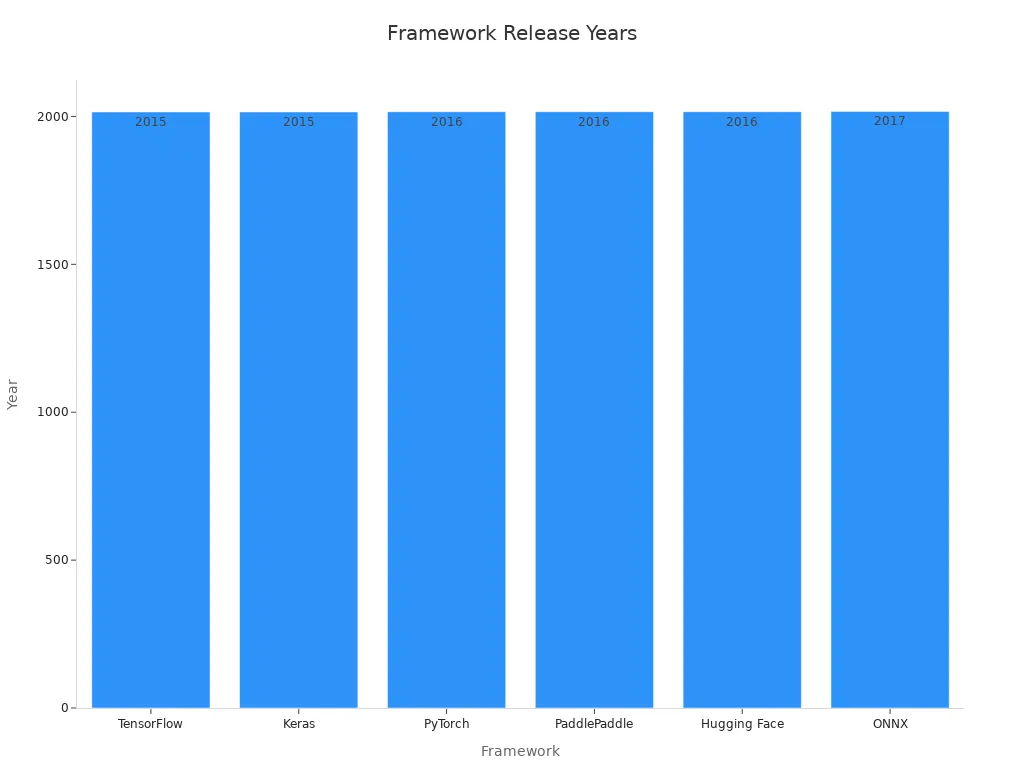Understanding Inference Machine Vision Systems in 2025

An inference machine vision system processes visual data to make decisions or predictions instantly. These systems act as the "brain" behind modern machine vision setups, using AI to analyze images and extract meaningful insights. Their ability to handle real-time data has made them essential in industries like manufacturing, healthcare, retail, and transportation. For example, predictive analytics in manufacturing has cut downtime by 35%, saving companies millions annually. Similarly, intelligent claims processing in insurance has reduced handling time by 80%. These measurable impacts highlight how inference systems are driving change across sectors, making operations faster and more efficient.
Key Takeaways
- AI-powered vision systems study pictures fast to help industries like factories and hospitals.
- These systems make work easier by spotting mistakes, cutting down errors, and helping decisions happen faster.
- They work quickly and adjust to changes, making them accurate and able to grow with needs.
- Using these systems saves money and improves work, like less waiting time and quicker problem-solving.
- Picking the right tools and programs is key to making sure the system works well for the job.
What Is an Inference Machine Vision System?
Definition and Purpose
An inference machine vision system is a cutting-edge technology designed to process visual data and make decisions or predictions in real-time. Unlike traditional systems that rely on pre-programmed rules, these systems use advanced algorithms to analyze images, detect patterns, and draw conclusions instantly. They serve as the decision-making core of modern machine vision setups, enabling industries to achieve higher efficiency and accuracy.
Inference systems excel in dynamic environments where quick decisions are critical. For example, in manufacturing, they can identify defective products on an assembly line within milliseconds, preventing costly errors. Similarly, in healthcare, they assist in analyzing medical images to detect abnormalities, improving diagnostic accuracy.
These systems are powered by AI, which enhances their ability to adapt to complex tasks. By leveraging AI, inference systems can handle vast amounts of data, learn from it, and continuously improve their performance. This makes them indispensable in industries that demand precision and speed.
Key Differences from Traditional Machine Vision Systems
Traditional machine vision systems rely on fixed algorithms and predefined rules to process visual data. While effective for simple tasks, they struggle with complex or unpredictable scenarios. In contrast, inference machine vision systems use AI-driven models to analyze data dynamically. This allows them to adapt to new challenges and deliver more accurate results.
Here are some key differences:
- Flexibility: Traditional systems are rigid, while inference systems can adapt to changing conditions.
- Accuracy: AI-powered inference systems achieve higher accuracy by learning from data over time.
- Speed: Inference systems process data in real-time, making them ideal for time-sensitive applications.
- Scalability: Inference systems can handle large-scale operations, whereas traditional systems may require significant manual intervention.
| Feature | Traditional Machine Vision Systems | Inference Machine Vision Systems |
|---|---|---|
| Decision-Making Basis | Predefined rules | AI-driven models |
| Adaptability | Limited | High |
| Real-Time Processing | Limited | Yes |
| Learning Capability | None | Continuous |
For instance, next-generation AI accelerators can process billions of operations per second directly on the camera. This eliminates the need for high-bandwidth connections, a limitation often seen in traditional setups.
Role of AI in Inference Systems
AI plays a pivotal role in powering inference machine vision systems. It enables these systems to analyze complex data sets, identify patterns, and make decisions with unparalleled accuracy. AI models, such as deep learning and neural networks, form the backbone of these systems, allowing them to perform tasks that were once impossible for traditional systems.
AI-driven inference systems are transforming industries by automating processes and reducing human error. For example, Volkswagen uses AI to optimize assembly lines, enhancing production efficiency and quality. Similarly, General Electric employs predictive maintenance powered by AI to minimize equipment downtime.
The integration of AI also supports real-time inferences, which are crucial for applications like autonomous vehicles and medical imaging. Benchmarks such as MLPerf Inference evaluate the performance of AI models, ensuring they meet the demands of real-world scenarios. These benchmarks assess various aspects, including edge device performance and mobile device capabilities, highlighting the versatility of AI in inference systems.
By leveraging AI, inference machine vision systems can process data faster, adapt to new challenges, and deliver consistent results. This makes them a cornerstone of modern technology, driving innovation across multiple sectors.
How Inference Machine Vision Systems Work

The Inference Process Explained
Inference in machine vision involves analyzing visual data to make decisions or predictions. This process begins when the system captures an image or video frame. The data then passes through an AI model trained to recognize patterns, objects, or anomalies. The system uses this analysis to generate real-time inferences, which are actionable insights or decisions.
For example, in a manufacturing setup, the system might detect defective products on a conveyor belt. It identifies these defects by comparing the captured image against a trained dataset. The system then flags the defective item for removal, ensuring quality control.
To better understand how this process works, consider the following workflows:
| Workflow Description | Example Output |
|---|---|
| Package Detection and Counting Workflow | Total count of packages detected as they pass a line, e.g., 'Total count = 1' for the first instance. |
| PCB Component Verification Workflow | Count of components detected on a PCB, e.g., '{ "IC": 7, "Connector": 12, ... }' for various components. |
These workflows highlight how inference systems transform raw data into meaningful outputs. By automating such tasks, you can achieve greater efficiency and accuracy in your operations.
Components: Hardware, Software, and Algorithms
An inference machine vision system relies on three key components: hardware, software, and algorithms. Each plays a critical role in ensuring the system's performance and reliability.
-
Hardware: The hardware includes cameras, sensors, and processors. Cameras capture high-resolution images, while processors like GPUs or FPGAs handle the computational load. FPGAs, in particular, excel in real-time processing due to their ability to perform multiple tasks simultaneously.
-
Software: The software manages the system's operations and integrates AI models. It processes the captured data, applies algorithms, and generates outputs. Modern software platforms also support edge computing, enabling faster processing without relying on cloud servers.
-
Algorithms: Algorithms form the backbone of the system. These AI-driven models analyze data, identify patterns, and make predictions. Deep learning algorithms, for instance, are highly effective in recognizing complex patterns in images.
By combining these components, the system delivers high accuracy and real-time inferences. This makes it ideal for applications like defect detection, medical imaging, and autonomous navigation.
Edge Computing and Real-Time Processing
Edge computing has revolutionized how inference machine vision systems operate. By processing data locally, edge computing eliminates the delays associated with cloud-based systems. This ensures faster reaction times, which are crucial for time-sensitive applications.
Several technologies enhance the performance of edge computing:
- FPGAs are designed for low-latency operation due to their inherent parallelism and direct hardware control.
- Unlike general-purpose processors, FPGAs can perform multiple tasks concurrently, making them ideal for real-time processing.
- Edge AI processes data instantly, which is essential for applications like manufacturing defect detection and security threat monitoring.
- By avoiding cloud delays, edge AI enhances operational efficiency and ensures faster decision-making.
For example, in autonomous vehicles, edge computing enables the system to process visual data in real-time. This allows the vehicle to detect obstacles and make split-second decisions, ensuring safety. Similarly, in manufacturing, edge AI helps identify defects on production lines without any delay.
By leveraging edge computing, you can achieve real-time inferences with minimal latency. This not only improves the system's performance but also enhances its reliability in critical applications.
Applications of Inference Machine Vision Systems in 2025

Object Detection and Recognition in Manufacturing
Inference machine vision systems have revolutionized manufacturing by enabling precise object detection and recognition. These systems analyze visual data in real-time to identify defects, count items, or verify assembly accuracy. For example, they can detect faulty components on a production line and remove them instantly, ensuring quality control in manufacturing. This automation reduces human error and enhances efficiency.
By using AI inference models, manufacturers achieve high-performance inference capabilities. These models process data rapidly, allowing real-time inferences that improve decision-making. For instance, a system might analyze thousands of products per hour, flagging defects with unmatched accuracy. This ensures consistent quality while minimizing waste. The integration of AI-driven algorithms also allows these systems to adapt to new challenges, making them indispensable in modern factories.
Healthcare and Medical Imaging
In healthcare, inference machine vision systems play a critical role in diagnostics and medical imaging. These systems process complex visual data to deliver real-time diagnostics with exceptional accuracy. For instance, AI-powered models analyze X-rays or MRIs to detect abnormalities, such as tumors or fractures, within seconds. This speeds up diagnosis and improves patient outcomes.
Clinical trials have demonstrated the effectiveness of these systems. A deep learning model achieved 87% sensitivity and 92% specificity in distinguishing COVID-19 from other lung diseases, with an AUC of 0.95. Similarly, the Skinvision app reported a 95% early detection rate for skin cancer. AI-driven laboratory systems also achieved mean AUCs of 0.98 and 0.94 in diagnostic accuracy for lab tests. These results highlight the transformative potential of inference systems in healthcare.
By leveraging real-time processing, these systems enhance the efficiency of medical workflows. They reduce the burden on healthcare professionals and ensure timely, accurate diagnostics. This makes them a cornerstone of modern medical technology.
Retail and Customer Behavior Analysis
Retailers use inference machine vision systems to analyze customer behavior and optimize operations. These systems process visual data from cameras to track foot traffic, monitor shelf activity, and study purchasing patterns. For example, they can identify which products attract the most attention or detect when shelves need restocking.
Real-time inferences allow retailers to make data-driven decisions instantly. For instance, a system might alert staff to replenish a popular item before it runs out, ensuring customer satisfaction. AI algorithms also enable personalized marketing by analyzing customer preferences. This improves the shopping experience and boosts sales.
The integration of high-performance inference systems in retail enhances operational efficiency. By automating tasks like inventory management and customer analysis, these systems save time and resources. They also provide valuable insights that help businesses stay competitive in a fast-paced market.
Autonomous Vehicles and Transportation
Inference machine vision systems have become a cornerstone of autonomous vehicles, enabling them to navigate complex environments with precision. These systems process visual data in real-time, allowing vehicles to detect objects, recognize road signs, and avoid obstacles. By leveraging AI, they ensure safe and efficient transportation.
AI inference models, such as YOLOv5s, have significantly enhanced the performance of these systems. Upgrades to the YOLOv5s algorithm improved accuracy, recall, and mean Average Precision (mAP). These advancements ensure that the system can make real-time inferences while maintaining efficient computational resource usage. For example, the model's inference time remains in the millisecond range, enabling vehicles to respond instantly to dynamic situations. Real-world testing has shown that these models reliably acquire target position and depth information, improving decision-making and obstacle avoidance.
The integration of high-performance inference systems in autonomous vehicles has revolutionized transportation. These systems deliver real-time diagnostics, ensuring that vehicles operate safely and efficiently. By automating tasks like lane detection and pedestrian recognition, they reduce human error and enhance road safety. This level of automation represents a significant leap forward in the transportation industry.
Emerging Use Cases in 2025
The applications of inference machine vision systems continue to expand in 2025. Beyond traditional industries, new use cases are emerging that leverage the power of AI and real-time processing. For instance, smart cities are adopting these systems to monitor traffic flow and optimize urban planning. By analyzing visual data from cameras, they can identify congestion patterns and implement solutions to improve efficiency.
In agriculture, inference systems are transforming how crops are monitored and harvested. AI-powered models analyze images of fields to detect pests, assess crop health, and predict yields. This level of precision ensures higher quality and reduces waste. Similarly, in the energy sector, these systems are being used to inspect infrastructure, such as pipelines and wind turbines, for defects. Real-time inferences allow for immediate action, preventing costly failures.
The integration of inference engine machine vision systems into these emerging applications highlights their versatility. By combining AI, real-time processing, and advanced algorithms, these systems are driving innovation across industries. As you explore these technologies, you’ll discover their potential to reshape the future.
Benefits and Challenges of Inference Machine Vision Systems
Benefits: Speed, Accuracy, and Scalability
Inference machine vision systems deliver unmatched speed, accuracy, and scalability, making them indispensable for modern applications. Optimized AI models significantly enhance system performance, enabling faster real-time processing and predictions. For example:
- Optimized models operate 7.011× faster than non-optimized versions.
- Specific models like Shuffle-V2 and MobileNet-V2 achieve speedups of 13.6× and 16.7×, respectively.
- Models with lower FLOPS experience greater reductions in inference time, ensuring rapid data analysis.
These advancements allow you to process large volumes of visual data efficiently, making real-time applications like defect detection and diagnostics more reliable. The scalability of these systems ensures they adapt to growing operational demands, maintaining high-quality performance across industries.
By leveraging AI-driven inference systems, you can achieve faster decision-making and improve operational efficiency, whether in manufacturing, healthcare, or transportation.
Challenges: Hardware Limitations and Costs
Despite their benefits, inference machine vision systems face challenges related to hardware limitations and costs. High initial investments in cameras, lenses, and accessories can deter smaller businesses from adopting these systems. Integration complexities arise when connecting with non-standard setups, requiring additional configuration efforts. Scalability also poses a challenge, as expanding operations often demands further investments in hardware or software.
| Evidence Type | Description |
|---|---|
| High Initial Investment | Significant upfront costs for cameras, lenses, and accessories can hinder smaller businesses. |
| Complexity in Integration | Challenges arise when integrating with non-Siemens systems due to additional configuration needs. |
| Scalability Limitations | Scaling operations may require further investments in hardware or software to maintain performance. |
Understanding these challenges helps you plan effectively, ensuring smooth integration and long-term efficiency.
Addressing Ethical Concerns and Data Privacy
As AI-powered inference systems process vast amounts of visual data, ethical concerns and data privacy become critical considerations. These systems often analyze sensitive information, such as medical diagnostics or customer behavior, raising questions about data security and misuse. You must ensure compliance with privacy regulations like GDPR or HIPAA to protect user data.
Transparency in AI model training and data usage builds trust and mitigates ethical concerns. Implementing robust encryption and anonymization techniques further safeguards sensitive information.
By addressing these issues proactively, you can harness the full potential of inference machine vision systems while maintaining ethical standards and data integrity.
Choosing and Implementing an Inference Engine Machine Vision System
Factors to Consider When Selecting a System
Choosing the right inference engine machine vision system involves evaluating several factors to ensure it meets your needs. Start by assessing the hardware requirements. GPUs, FPGAs, and CPUs each offer unique advantages. GPUs are cost-effective and excel in AI applications requiring deep learning. FPGAs provide low-latency processing, making them ideal for real-time applications. CPUs, while versatile, may not match the performance of GPUs or FPGAs for complex tasks.
| Criteria | GPUs | FPGAs | CPUs |
|---|---|---|---|
| Real-time Processing | Suitable for real-time processing, common in AI applications | Offer low-latency processing, ideal for real-time applications | Capable but may not perform as well as GPUs and FPGAs |
| Cost Considerations | Cost-effective for performance, common in AI | More expensive but justified by customization and low power | Typically cost-effective and readily available |
| Ease of Programming | Widely supported, straightforward for developers | Complex, requires specialized knowledge | Easy to program, compatible with many languages |
| Application Focus | Preferred for AI applications involving deep learning | Favored in low-latency applications | Versatile, used in various scenarios |
Consider the system's scalability and compatibility with your existing infrastructure. A scalable system ensures it can handle growing data and applications without compromising performance. Additionally, prioritize systems that support real-time processing to meet the demands of time-sensitive applications.
Tools and Frameworks for Implementation
Selecting the right tools and frameworks is crucial for implementing an inference engine machine vision system. Popular frameworks like TensorFlow, PyTorch, and Keras offer robust support for AI model development and deployment. TensorFlow provides high-performance computation and scalability, while PyTorch offers flexibility with its dynamic computation graph. Keras is user-friendly, making it ideal for prototyping.
| Parameters | TensorFlow | Keras | PyTorch | PaddlePaddle | ONNX | Hugging Face |
|---|---|---|---|---|---|---|
| Developer | Google Brain Team | François Chollet (Google) | Facebook’s AI Research lab | Baidu | Facebook and Microsoft | Hugging Face Inc. |
| Release Year | 2015 | 2015 | 2016 | 2016 | 2017 | 2016 |
| Primary Language | Python, C++ | Python | Python, C++ | Python, C++ | Python, C++ | Python |
| Design Philosophy | Large-scale machine learning; high performance; flexibility | User-friendliness; modularity and composability | Flexibility and fluidity for research and development | Industrial-level large-scale application; ease of use | Interoperability; shared optimization | Democratizing AI; NLP |

Choose a framework that aligns with your system's requirements and your team's expertise. For example, TensorFlow is excellent for large-scale applications, while Keras simplifies model creation for beginners.
Best Practices for Deployment
Deploying an inference engine machine vision system requires careful planning to maximize efficiency and performance. Follow these best practices:
- Choose the Right Infrastructure: Align the deployment infrastructure with the complexity of your AI models and latency requirements.
- Containerization: Use containers to ensure consistency across different environments.
- Model Versioning: Track iterations of your models to enable easy rollbacks if needed.
- A/B Testing: Test multiple versions of your models to identify the best performer.
- Monitoring Pipeline: Set up logging, alerts, and dashboards to track the health of your system.
| Optimization Technique | Description |
|---|---|
| Inference Optimization Techniques | Techniques like low-rank factorization and early exit mechanisms that enhance model performance. |
| Deployment Strategy | Choosing optimal platforms and locations for model deployment to reduce latency and improve reliability. |
| Infrastructure Optimization | Streamlining network architecture to minimize data transfer time and improve inference speed. |
| Caching vs. Memoization | Techniques to store intermediate results to speed up processing. |
| Parallelism and Batching | Utilizing multiple servers and grouping inputs to optimize inference. |
Effective deployment ensures your system delivers real-time predictions with high accuracy. Regular monitoring and retraining keep your models aligned with changing data patterns, maintaining their quality and reliability.
Inference machine vision systems are reshaping industries in 2025 by delivering real-time visual data analysis that drives efficiency and innovation. Their transformative potential is evident across sectors:
- A global automotive manufacturer reduced production time by 35% and improved defect detection by 92%.
- Precision electronics manufacturers achieved 96% accuracy in predicting micro-level defects.
- Industrial equipment manufacturers cut energy consumption by 42% and minimized material waste by 55%.
These systems enable:
- Hyper-personalized manufacturing that adapts to customer preferences.
- Faster decision-making through edge computing on equipment.
- Sustainable operations that optimize resources and meet environmental standards.
Adopting these systems strategically allows you to harness their power for scalable, adaptive solutions that align with modern demands.
FAQ
What industries benefit the most from inference machine vision systems?
You’ll find these systems most impactful in manufacturing, healthcare, retail, and transportation. They improve efficiency, accuracy, and decision-making in real-time. For example, manufacturers use them for defect detection, while healthcare professionals rely on them for faster diagnostics.
How do inference systems differ from traditional machine vision systems?
Inference systems use AI to analyze data dynamically, while traditional systems rely on fixed rules. This makes inference systems more adaptable, accurate, and scalable. They also process data in real-time, which is essential for applications like autonomous vehicles and medical imaging.
Can small businesses afford to implement these systems?
Yes, but you’ll need to plan carefully. While initial costs can be high, scalable solutions and cloud-based options make them accessible. Start with smaller setups and expand as your needs grow. Many vendors offer flexible pricing models to support smaller operations.
What hardware is essential for deploying an inference machine vision system?
You’ll need cameras, sensors, and processors like GPUs or FPGAs. GPUs handle AI tasks efficiently, while FPGAs excel in real-time processing. Choose hardware based on your application’s complexity and latency requirements. High-resolution cameras ensure accurate data capture.
How can you address data privacy concerns with these systems?
Ensure compliance with regulations like GDPR or HIPAA. Use encryption and anonymization techniques to protect sensitive data. Be transparent about how your system processes and stores information. This builds trust and ensures ethical use of the technology.
See Also
Exploring Component Counting Vision Systems Trends for 2025
Understanding Edge AI Applications in Real-Time Machine Vision
A Comprehensive Guide to Image Processing in Machine Vision
